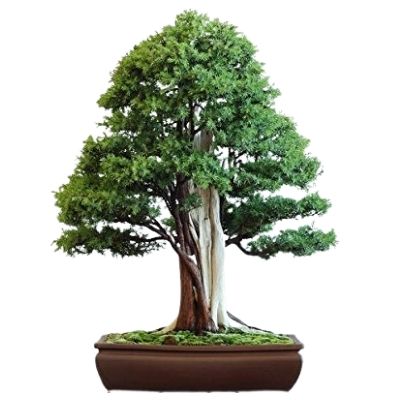
Common Juniper
(Juniperus communis)
Country of Origin : Europe, Asia and North America
Bonsai Styles : Informal upright, semi-cascade, cascade
Zone : 2 – 7
Common juniper bonsai tree is an evergreen conifer.
It has prickly needle like densely branching foliage which can range from dark green to blueish green in color. The foliage has pale undersides.
The common juniper produces round berry-like green colored fruits that ripen to blue-black color after almost two years.
The trunk of a common juniper bonsai tree eventually becomes gnarled and twisted, making it ideal for driftwood.
Juniperus communis bonsai trees are excellent subjects for bonsai in the contemporary sculptural style.
The species includes several prostrate cultivars, including ‘Hornibrookii‘ and ‘Repanda‘, in addition to dwarf and slow-growing varieties.
- Juniperus communis ‘Hornibrookii’ – Its growing habit is slightly upward ascending, making it look layered. With silver-white bands over the needles and green underneath, it has short, sharp needles. Over the winter months, the color becomes brownish, changing from the rich silver-green of summer.
- Juniperus communis ‘Repanda’ – The shrub grows as a dense, prostrate carpet of evergreen foliage. The foliage has a unique texture compared to other junipers. The thin branch tips nod and branches are densely arranged, with soft, narrow, dark green needles decorated with white bands. Foliage color during winter becomes bronze.
A wild-grown juniper bonsai is the best example of common juniper bonsai tree. However, it is not widely available and is not commercially produced. It is common for good specimens of common juniper bonsai tree to be found in private collections, created by bonsai enthusiasts.
Best location to keep Common Juniper Bonsai
Juniperus communis bonsai tree thrives in full sun throughout the growing season. However, it can also be placed in partial shade conditions.
The Juniperus communis plant is found naturally throughout most of the northern hemisphere, where it is hardy in temperate regions.
But make sure to move the common juniper tree bonsai in a frost free area in places where the temperature drops below 14°F (-10°C).
Refer sunlight requirements for indoor plants for more indoor gardening ideas.
Propagation of Common Juniper
Common Juniper plant can be propagated using softwood cutting.
Watering Common Juniper Bonsai
Water common juniper bonsai tree generously in the time of summer.
In spring and fall, water the bonsai sparingly making sure that the soil never dries out.
Keep the bonsai soil moist in the time of winter.
Avoid water-logging the bonsai soil as it will retard the growth of the common juniper bonsai tree.
Wiring Common Juniper Bonsai
Spring and fall is a preferred time for wiring common juniper bonsai.
Make sure not to trap any foliage under the wire.
Do not leave the wires in place for more than one year.
Pruning Common JuniperBonsai
When to prune Common Juniper bonsai?
How to prune Common Juniper bonsai?
In late spring, cut back the old shoots and branches to the woody growth.
Take care not to cut through the needles themselves. Just prune above the cluster of needles.
Pinching Common Juniper Bonsai
The main goal of pinching is to keep the structure of the foliage dense. This can be done by pinching the new shoots protruding out from the bonsai outline.
Pinch the growing tips of new shoots with your fingers from early spring to fall to maintain the desired bonsai style.
Repotting Common Juniper Bonsai
When to repot Common Juniper bonsai?
In mid to late spring, common juniper bonsai tree can be repotted every 2 to 3 years.
However, when the tree becomes 10 years old, you can repot the common juniper bonsai tree every 5 years or so.
Repot the bonsai tree when it becomes rootbound in the bonsai pot.
Do not prune more than 1/3 of the roots when repotting the common juniper tree.
You can use standard bonsai soil.
OR
Common juniper bonsai tree does well in slightly alkaline bonsai soil. You can also use a mix of 2 part coarse sand, 1 part akadama and 1 part peat.
Must Read: Bonsai Soil Recipes
Must read : Choosing the right bonsai container
Feeding Common Juniper Bonsai
Feed your common juniper bonsai tree with a high-nitrogen fertilizer in early spring.
Apply a general fertilizer every couple of months in the summer.
Do not apply fertilizer in the fall and winter season.
Diseases and pest of Common Juniper Bonsai
The presence of spider mites, scaled insects, and caterpillars can be problematic. If you cannot remove them by hand, use a systemic insecticide.
Foliage that is crowded can sometimes suffer from fungal infections. Systemic fungicides can be used to combat this.
The common Juniper bonsai tree is susceptible to sap sucking insects.
A jet of water is generally effective in removing aphids and scale insects, but a systemic insecticide should be applied if the infestation is severe.
Common Juniper bonsai care
When exposed to frost, junipers turn yellow or brown. Although unsightly, this doesn’t harm the common juniper bonsai tree.
As spring approaches, the tree will get green again.
The foliage on a healthy common juniper bonsai tree needs to be thinned periodically, and the outline is reconstructed as new shoots emerge from the intersections of branches.
What to look for when buying Common Juniper Bonsai
You should look for a common juniper bonsai tree with a series of curves. These curves should not have any acute and sharp bends. It does not look natural for common juniper bonsai trees to have sharp trunk turns.


1 comment
Very interesting information!Perfect just what I was looking for! “If you bungle raising your children, I don’t think whatever else you do matters.” by Jacqueline Lee Bouvier Kennedy Onassis.